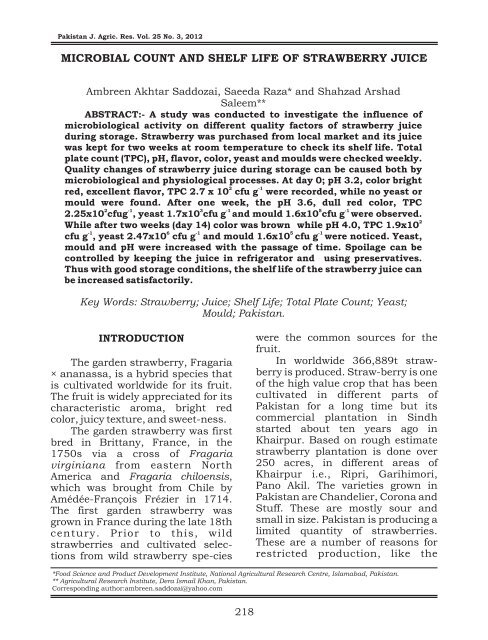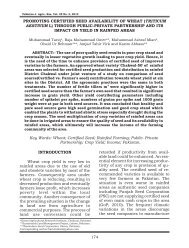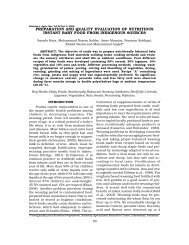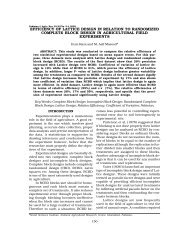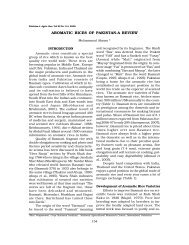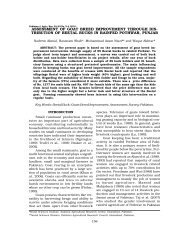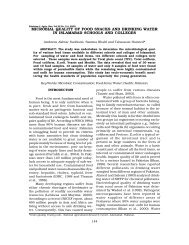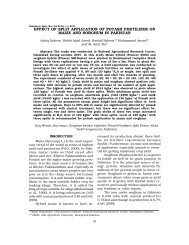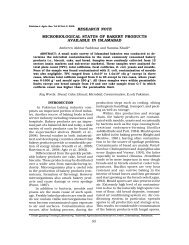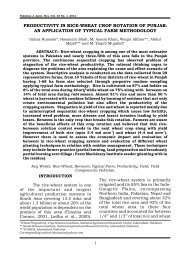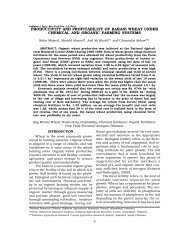microbial count and shelf life of strawberry juice - PJAR
microbial count and shelf life of strawberry juice - PJAR
microbial count and shelf life of strawberry juice - PJAR
You also want an ePaper? Increase the reach of your titles
YUMPU automatically turns print PDFs into web optimized ePapers that Google loves.
Pakistan J. Agric. Res. Vol. 25 No. 3, 2012MICROBIAL COUNT AND SHELF LIFE OF STRAWBERRY JUICEAmbreen Akhtar Saddozai, Saeeda Raza* <strong>and</strong> Shahzad ArshadSaleem**ABSTRACT:- A study was conducted to investigate the influence <strong>of</strong>microbiological activity on different quality factors <strong>of</strong> <strong>strawberry</strong> <strong>juice</strong>during storage. Strawberry was purchased from local market <strong>and</strong> its <strong>juice</strong>was kept for two weeks at room temperature to check its <strong>shelf</strong> <strong>life</strong>. Totalplate <strong>count</strong> (TPC), pH, flavor, color, yeast <strong>and</strong> moulds were checked weekly.Quality changes <strong>of</strong> <strong>strawberry</strong> <strong>juice</strong> during storage can be caused both bymicrobiological <strong>and</strong> physiological processes. At day 0; pH 3.2, color bright2 -1red, excellent flavor, TPC 2.7 x 10 cfu g were recorded, while no yeast ormould were found. After one week, the pH 3.6, dull red color, TPC2 -1 3 -1 5 -12.25x10 cfug , yeast 1.7x10 cfu g <strong>and</strong> mould 1.6x10 cfu g were observed.2While after two weeks (day 14) color was brown while pH 4.0, TPC 1.9x10-1 6 -1 5 -1cfu g , yeast 2.47x10 cfu g <strong>and</strong> mould 1.6x10 cfu g were noticed. Yeast,mould <strong>and</strong> pH were increased with the passage <strong>of</strong> time. Spoilage can becontrolled by keeping the <strong>juice</strong> in refrigerator <strong>and</strong> using preservatives.Thus with good storage conditions, the <strong>shelf</strong> <strong>life</strong> <strong>of</strong> the <strong>strawberry</strong> <strong>juice</strong> canbe increased satisfactorily.Key Words: Strawberry; Juice; Shelf Life; Total Plate Count; Yeast;Mould; Pakistan.INTRODUCTIONThe garden <strong>strawberry</strong>, Fragaria× ananassa, is a hybrid species thatis cultivated worldwide for its fruit.The fruit is widely appreciated for itscharacteristic aroma, bright redcolor, juicy texture, <strong>and</strong> sweet-ness.The garden <strong>strawberry</strong> was firstbred in Brittany, France, in the1750s via a cross <strong>of</strong> Fragariavirginiana from eastern NorthAmerica <strong>and</strong> Fragaria chiloensis,which was brought from Chile byAmédée-François Frézier in 1714.The first garden <strong>strawberry</strong> wasgrown in France during the late 18thcentury. Prior to this, wildstrawberries <strong>and</strong> cultivated selectionsfrom wild <strong>strawberry</strong> spe-cieswere the common sources for thefruit.In worldwide 366,889t <strong>strawberry</strong>is produced. Straw-berry is one<strong>of</strong> the high value crop that has beencultivated in different parts <strong>of</strong>Pakistan for a long time but itscommercial plantation in Sindhstarted about ten years ago inKhairpur. Based on rough estimate<strong>strawberry</strong> plantation is done over250 acres, in different areas <strong>of</strong>Khairpur i.e., Ripri, Garihimori,Pano Akil. The varieties grown inPakistan are Ch<strong>and</strong>elier, Corona <strong>and</strong>Stuff. These are mostly sour <strong>and</strong>small in size. Pakistan is producing alimited quantity <strong>of</strong> strawberries.These are a number <strong>of</strong> reasons forrestricted production, like the*Food Science <strong>and</strong> Product Development Institute, National Agricultural Research Centre, Islamabad, Pakistan.** Agricultural Research Institute, Dera Ismail Khan, Pakistan.Corresponding author:ambreen.saddozai@yahoo.com218
MICROBIAL COUNT AND SHELF LIFE OF STRAWBERRY JUICEaddition to being consumed fresh,strawberries can be frozen, as well asdried <strong>and</strong> used in prepared foods,such as cereal bars. Strawberries area popular addition to dairy products,as in <strong>strawberry</strong>-flavored ice cream,milkshakes, smoothies, <strong>and</strong> yogurts.Depending on area, <strong>strawberry</strong> pie,<strong>strawberry</strong> rhubarb pie, or <strong>strawberry</strong>shortcake are also popular.The aim <strong>of</strong> present studies was toinvestigate the <strong>shelf</strong> <strong>life</strong> <strong>of</strong> <strong>strawberry</strong><strong>juice</strong> (<strong>microbial</strong> <strong>and</strong> physicalchanges) at room temperature.MATERIALS AND METHODStrawberries were purchasedfrom local market <strong>of</strong> Islamabad,washed thoroughly, processed into<strong>juice</strong> <strong>and</strong> stored at room temperatureto determine the <strong>shelf</strong> <strong>life</strong> <strong>of</strong> prepared<strong>juice</strong> at Food Science <strong>and</strong> ProductDevelopment Institute, NationalAgricultural Research Centre(NARC), Islamabad. The prepared<strong>juice</strong>s were analyzed for sensoryevaluation by a panel <strong>of</strong> 10 judges a(Larmond, 1977). The parametersincluded color, taste <strong>and</strong> flavor. The<strong>juice</strong> was also tested for microbiologicalanalyses i.e., total plate<strong>count</strong>, yeast <strong>and</strong> moulds (FAO,1992). According to this method50ml sample was homogenized withButter field's phosphate buffer (pH7.2). Serial dilutions <strong>of</strong> <strong>juice</strong> wereprepared by transferring 1ml <strong>of</strong>sample in 9ml <strong>of</strong> sterile phosphatebuffer in test tubes. After eachdilution, the contents were mixed invortex-mixer for 10 sec. One mililitervolumes <strong>of</strong> each dilution weretransferred to Petri dish with plate<strong>count</strong> agar <strong>and</strong> mixed with mediumin triplicate. After solidification Petri0dishes were incubated at 35 C for48h for total plate <strong>count</strong> <strong>and</strong> coloniesformed on the surface <strong>and</strong> in themedia were <strong>count</strong>ed. The total <strong>count</strong>was calculated from the mean <strong>count</strong><strong>of</strong> triplicate <strong>of</strong> Petri dishes,considering the dilutions.For yeast <strong>and</strong> mould spreadplate method was used. Yeast growthwas checked on plate <strong>count</strong> agaramended with 40 ppm Chloramphenicol(added as antibacterialagent). Potato dextrose agar wasused to detect moulds. About 0.1mlinoculum <strong>of</strong> each dilution was placedon the center <strong>of</strong> solidified potatodextrose agar <strong>and</strong> plate <strong>count</strong> agar ina Petri plate <strong>and</strong> used a sterile bentglass rod for spreading. Theinoculum was spread on the surface0<strong>of</strong> media <strong>and</strong> incubates at 25 C for96h.RESULT AND DISCUSSIONThe considerable changes inquality parameter were reported inthe sample (<strong>strawberry</strong> <strong>juice</strong>) duringstorage at room temperature (Table1). It is evident that the pH value <strong>of</strong>fresh <strong>juice</strong> was 3.2. Deirdre et al.(1999) had also reported the pHrange <strong>of</strong> <strong>strawberry</strong> <strong>juice</strong> as 3.4-3.6which shows it is acidic in nature.The pH <strong>of</strong> the <strong>juice</strong> increased withthe passage <strong>of</strong> time. At the start <strong>of</strong>study, the pH <strong>of</strong> the sample was 3.2,while after 7 days the pH increased to3.6 <strong>and</strong> further increase in pH i.e.,4.0 was recorded after two weeks <strong>of</strong>storage (Table 1). The increase in thepH is might be due to the increase inalcoholic contents in the <strong>juice</strong> duringstorage (Forney et al., 2000).At day 0, the color <strong>of</strong> the samplewas bright clear red. On day 7, a littlechange in the color was observed.However, a dark red color wasrecorded later. On day 14, brown220
AMBREEN AKHTAR SADDOZAI ET AL.Table 1.Shelf <strong>life</strong> <strong>of</strong> <strong>strawberry</strong> <strong>juice</strong>Day pH Color Flavor Total plate<strong>count</strong>(cfug -1 )Mould(cfug -1 )Yeast(cfug -1 )Day 0 3.2 Bright, clear red Excellent 2.7×10 2 Nil NilDay 7 3.6 Dull red Satisfactory 2.25×10 2 1.4×10 3 1.7×10 3Day 14 4.0 Brown Unsatisfactory 1.9×10 2 1.6×10 5 2.47×10 6color was recorded. Studies <strong>of</strong> Pino etal. (2001) <strong>and</strong> Silas et al. (2006)showed that a progressive changefrom a bright, clear red to dull red<strong>and</strong> finally to brown darkening in thecolor <strong>of</strong> <strong>strawberry</strong> occur during thestorage at room temperature. Theyalso noticed that color changesoccurring in the <strong>juice</strong> could partiallybe overcome by storage at lowtemperature.Strawberries are well known fortheir exquisite flavor <strong>and</strong> are widelyused to prepare <strong>juice</strong>s (Bood <strong>and</strong>Zabetakis, 2002). The flavor <strong>of</strong> fresh<strong>strawberry</strong> <strong>juice</strong> was excellent, whileafter 7 days storage, the flavor wassatisfactory. The flavor became unsatisfactoryafter14 days <strong>of</strong> storage.With the passage <strong>of</strong> time the flavor <strong>of</strong>the sample was degraded due tocompositional changes in thesample. Strawberry <strong>juice</strong> flavorcompounds have shown low stabilityduring storage in various studies(Mosqueda-Melgar et al., 2008).Lundahl et al. (2006) observedpronounced losses <strong>of</strong> ascorbic acid in<strong>strawberry</strong> <strong>juice</strong> with marked changein flavor during storage. Alcoholshave been identified as constituents<strong>of</strong> the aroma pr<strong>of</strong>ile in strawberries.The major alcohol identified in <strong>strawberry</strong><strong>juice</strong> was 1-butanol which wasaffected after a week <strong>of</strong> storage. Aftera long period <strong>of</strong> storage at roomtemperature, an increase in 1-butanol concentrations can renderan unpleasant flavor to the product,due to its strong, pungent smell <strong>and</strong>taste.Factors such as maturity at themoment <strong>of</strong> processing or <strong>strawberry</strong>variety, could substantially affect thecolor, flavor, pH <strong>and</strong> microbiologicalcharacteristics <strong>of</strong> <strong>strawberry</strong> <strong>juice</strong>(Forney et al., 2000). The total plate2<strong>count</strong> decreased from 2.7×10 to2 -12.25 ×10 cfug during one week storageat room temperature. After 22 -1weeks it decreased to 1.9×10 cfugdue to low pH <strong>of</strong> the sample. Bacterialgrowth is eliminated to a verylarge extent by acidity, bacterialspores will not germinate in <strong>juice</strong>with the pH less than 4.5 <strong>and</strong>vegetative cells <strong>of</strong> pathogenicbacteria will not grow at pH less than4.0 (Smelt et al., 1982).Moreover, no mould <strong>and</strong> yeastgrowth was observed in the sample at3 -10 day. After 7 days 1.4×10 cfug3 -1yeast, 1.7×10 cfug mould were5 -1recorded. After 2 weeks 1.6×10 cfug6 -1yeast <strong>and</strong> 2.47×10 cfug mould wererecorded. The reason <strong>of</strong> yeast growthis due to the presence <strong>of</strong> sugars(carbohydrates) in the sample.According to the Gulf st<strong>and</strong>ardsthe maximum anticipated <strong>and</strong>permitted <strong>count</strong> <strong>of</strong> TPC for <strong>juice</strong>s is3 45.0 × 10 <strong>and</strong> 1 × 10 , respectively221
MICROBIAL COUNT AND SHELF LIFE OF STRAWBERRY JUICE(Table 2). While in the present studythe TPC is lower than the anticipatedvalue as well as permitted value.However the bacterial load isdecreased with the passage <strong>of</strong> time.This is due to the lower pH than that<strong>of</strong> the pH needed for bacterialgrowth.The Gulf st<strong>and</strong>ards show thatthe yeast <strong>and</strong> mould <strong>count</strong> should3not be more than 1 × 10 cfu ml-1 in<strong>juice</strong>s. Present study shows that atday 0, there was no yeast growth inthe sample but with the passage <strong>of</strong>time the yeast growth was observed.The microbiological status <strong>of</strong> <strong>strawberry</strong><strong>juice</strong> is not affected very muchduring storage at room temperatureif it is carefully h<strong>and</strong>led. However,some studies have shown a significantincrease in the microbiologicalpopulations <strong>of</strong> <strong>strawberry</strong><strong>juice</strong> during storage. The TPC increasedduring storage in somecases. Moreover, mould <strong>and</strong> yeastgrowth has also been observed byvarious researchers during theirwork on <strong>strawberry</strong> <strong>juice</strong> (Amanatidouet al., 2003).The freshly prepared <strong>juice</strong> gotthe higher score <strong>and</strong> overall acceptabilitywas 9 (Table 3). But after 7days there was little change incolour, taste <strong>and</strong> flavor <strong>and</strong> overallacceptability was 5. After 14 daysoverall acceptability was 1.5. Thisshows the progressive deteriorationTable 2.CountGulf st<strong>and</strong>ard for microbiologicalcriteria for <strong>juice</strong>sMaximum <strong>count</strong>anticipated-1(cfuml )Maximum <strong>count</strong>permittedTotal plate <strong>count</strong> 5.0 × 10 3 1 × 10 4Yeast 100 1 × 10 3Mould 100 1 × 10 3Table 3.Sensory evaluation <strong>of</strong><strong>strawberry</strong> <strong>juice</strong>Duration (day) Color Flavor Taste Overallacceptability0 9 9 9 97 6 5 4 514 2 1 Not fit totaste<strong>and</strong> quality degradation <strong>of</strong> <strong>juice</strong>stored at room temperature.It is thus concluded that the<strong>strawberry</strong> <strong>juice</strong> quality is affectedduring storage by microbiological<strong>and</strong> physiological processes. Howeverthe spoilage can be controlled byprocessing <strong>and</strong> storage underaseptic/sanitation conditions. The<strong>shelf</strong> <strong>life</strong> <strong>of</strong> the <strong>strawberry</strong> <strong>juice</strong> canbe increased in a satisfactory way bykeeping in refrigeration <strong>and</strong> by usingpreservatives.LITERATURE CITEDAmanatidou, A. Slump, R. A. <strong>and</strong>Smid, E. J. 2003. Microbialinteractions on minimallyprocessed carrots under elevatedoxygen <strong>and</strong> carbondioxide concentrations. ActaHorti-culturae, 600: 621-628.Ayala-Zavala, J. F. Wang, S. Y.Wang, C. Y. <strong>and</strong> González-Aguilar, G. A. 2004. Effect <strong>of</strong>storage tem-peratures onantioxidant capa-city <strong>and</strong>a r o m a c o m p o u n d s i n<strong>strawberry</strong> fruit. LWT-FoodSci. <strong>and</strong> Technol. 37: 687-695.Bood, K. G. <strong>and</strong> Zabetakis, I. 2002.The biosynthesis <strong>of</strong> <strong>strawberry</strong>flavor (II): Biosynthetica n d m o l e c u l a r b i o l o g ystudies. J. Food Science, 67:2-8.1.5222
AMBREEN AKHTAR SADDOZAI ET AL.FAO, 1992. Manual <strong>of</strong> Food QualityControl, 4. Review, MicrobiologicalAnalysis FAO Food<strong>and</strong> Nutrition paper. Food<strong>and</strong> Agriculture Organization<strong>of</strong> the United Nation, Rome.Forney, C. F. Kalt, W. <strong>and</strong> Jordan,M. A. 2000. The composition<strong>of</strong> <strong>strawberry</strong> aroma isinfluenced by cultivar,maturity, <strong>and</strong> sto-rage. Hort.Science, 35: 1022-1026.Harris, L.J. Farber, J.N. Beuchat,L.R. Parish, M.E. Suslow, T.V.Garrett, E.H. <strong>and</strong> Busta, F.F.2003. Outbreaks associatedwith fresh produce, incidence,growth <strong>and</strong> survival <strong>of</strong> pathogensin fresh <strong>and</strong> fresh-cutproduce. Compr. Rev. FoodSci. Food Safe, 2:78-141.Larmond, E. 1977 LaboratoryM e t h o d s f o r s e n s o r yevaluation <strong>of</strong> foods. Researchbranch, Canada. Dept. <strong>of</strong>Agriculture Pub No.1637.Larsen, M. Poll, L. <strong>and</strong> Olsen, C. E.1992. Evaluation <strong>of</strong> the aromac o m p o s i t i o n o f s o m es t r a w b e r r y ( F r a g a r i aananassa Duch) cultivars byuse <strong>of</strong> odour threshold values.Zeitschrift für Lebensmitter-U n t e r s u c h u n g u n d -Forschung, 195: 536-539.Lundahl, D.S. McDaniel, M. R. <strong>and</strong>Wrolstad, R.E. 2006. Flavor,aroma, <strong>and</strong> compositionalchan-ges in <strong>strawberry</strong> <strong>juice</strong>con-centrate stored at 20° C.J. Agric. <strong>and</strong> Food Chem. 16:90-101.Mosqueda-Melgar, J. Raybaudi-Massilia, R. M. <strong>and</strong> Martín-Belloso, O. 2008. Nonthermalpasteurization <strong>of</strong> fruit <strong>juice</strong>sby combining high-intensitypulsed electric fields withnatural anti<strong>microbial</strong>s. Innov.Food Sci. <strong>and</strong> Emerging Tech.9: 328-340.Pino, J. A. Marbot, R. <strong>and</strong> Vázquez,C. 2001. Characterization <strong>of</strong>volatiles in <strong>strawberry</strong> guava(Psidium cattleianum Sabine)fruit. J. Agric. <strong>and</strong> FoodChem. 49: 5883-5887.Silas, R. Ronald E. <strong>and</strong> Wrolstad,2006. Effects <strong>of</strong> mold contamination<strong>and</strong> ultrafiltrationon the color stability <strong>of</strong> <strong>strawberry</strong><strong>juice</strong> <strong>and</strong> concentrate.J. Agric. <strong>and</strong> Food Chem. 60:130-145.Smelt, J.P.P.M. Ratjes, J.G.M.Crowther, J.S. <strong>and</strong> Verrios,C.T. 1982. Growth <strong>and</strong> toxinformation by colestridium atlow pH values. J. Appl.Bacteriol. 31: 525 - 529.223


